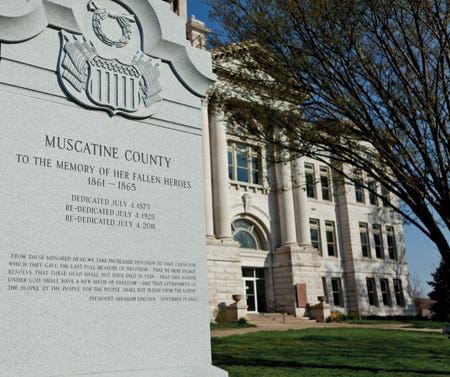
Public Buildings
Updating the Historic Muscatine County Courthouse in Iowa
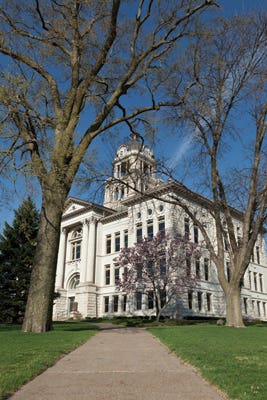
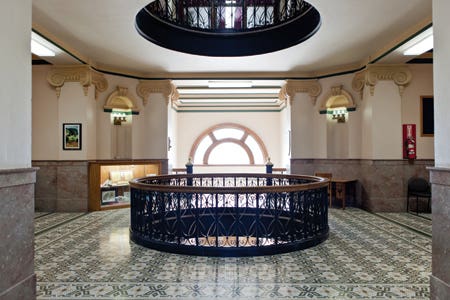
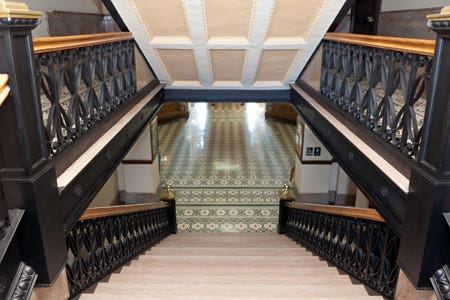
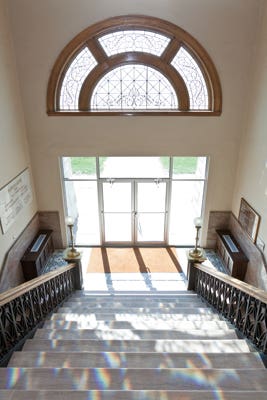
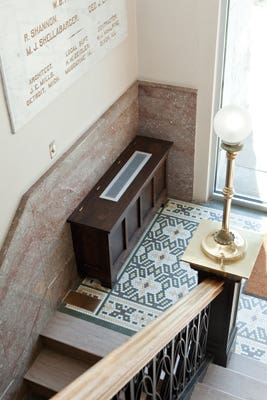

PROJECT
Muscatine County Courthouse, Muscatine, IA
ARCHITECT
Douglas J. Steinmetz, AIA, Cedar Rapids, IA
By Nancy A. Ruhling
In the Mississippi River city of Muscatine, IA, a grand county courthouse stands in the center of the old town square. For more than a century, visitors have stopped to admire the imposing three-story Beaux Arts building, whose copper-topped tower glows in the light of the sun. For too many decades, what they saw when they looked up to check the official time as told by the hands of its vintage clock, were not only the muscular Corinthian columns that bookend the magnificent front entrance but also the big-box heating and cooling compressors that all but overtook the rooftop. So when it came time to replace the 30-year-old antiquated HVAC system, which was leaking and beyond repair, the county supervisors sought not only a suitable sustainable solution but also an aesthetically pleasing one worthy of the building’s spot on the National Register of Historic Places.
Muscatine, onetime “Pearl Button Capital of the World” and short-time home of Mark Twain (in 1853-54, he reveled in its summer sunsets but joked that he was happy to report that he never saw a single sunrise) is 25 minutes from the Quad Cities. The people of Muscatine take fierce pride in their courthouse, perhaps because the first one burned down in 1864. It was reconstructed to the tune of $29,081.13 and the current one, which opened with the crack of the gavel on June 9, 1909, cost a whopping $150,000.
There was no question that this was to be a “green” project. The board was keen on capping energy costs and, several years before, had drilled a geothermal test well and built a 25,000-sq.ft. conservation learning center that used a geothermal heating and cooling system. The courthouse already had earned a federal ENERGY STAR certification when its century-old windows were replaced. The budget for the HVAC project was a little more than $1 million, and when price comparisons showed that a geothermal system would cost only $100,000 more than replacing the existing equipment, the supervisors hired mechanical engineer Vic Amoroso, president of North Liberty-based A&J Associates, to take charge of the project. “We were surprised that the cost difference of the two systems was insignificant,” says Sherry Seright, the county’s longtime budget director.
Going green brought additional upfront savings that were all but unexpected.
“Everything in the stars lined up,” says Amoroso. “It’s unusual because we got two grants – one from the U.S. Department of Energy and one from the Iowa State Department of Natural Resources. I’ve never had a project that got two. Each of them covered 25% of construction costs. But it wasn’t easy – the grant process took as long as the design and construction.”
Amoroso has completed a good number of historic projects, including the restoration and renovation of the 1902 Corning Opera House in Corning, IA. For the courthouse, he decided to pair a closed-loop geothermal system, which included the new 50,000-sq.ft. jail addition across the street, with a Variable Refrigerant Flow (VRF) zoning system and a CITY MULTI Dedicated Outdoor Air System (DOAS) from Mitsubishi Electric Cooling and Heating. “Although VRF zoning technology has long been popular in Europe, it’s just coming into favor in the United States,” says Amoroso. “I had used it only once before in a commercial project – in a school in southeast Iowa, but that building was new.”
Amoroso says the VRF system, which uses refrigerant instead of air as a heat-exchange medium, is perfect for Iowa, where winters are bone-chilling cold and summers are greenhouse humid. “We have to stay on top of the humidity,” he says, “because it degrades the finishes.” The refrigerant-based system, he adds, doesn’t need backup heat when connected to the geothermal loop. And the DOAS system sucks outdoor air into the courthouse, provides dehumidification without increasing energy use and makes the VRF system more efficient by readying outside air for the HVAC units and lessening the load on them. “The campus concept of the jail/courthouse geothermal loop is the key,” he says. “Yes, we could have done them separately, but this way we are spreading out the cost.”
The two systems work in tandem to maintain even temperatures in the two buildings. Heat pumps use excess heat to warm cold spots and heat water. Once the courthouse reaches the right temperature, excess heat is sent to the jail addition by the campus geothermal loop. When both buildings’ needs are met, excess heat is stored in the loop field for future use.
“Last summer, for instance, we had three weeks of over 100-degree temperatures,” Amoroso says. “The design basis is about 90 degrees. Because of the campus system, at 2 p.m. the temperatures in the geothermal field got too high, so we turned the air conditioning off in the courthouse, and we didn’t pick up a degree until after the sun set. This was a great help to the jail.”
The Mitsubishi modular units are small, a prime consideration for installation in the building, whose limestone walls are 2-ft. thick. “We could take them down the stairs to the basement easily,” he says. “There was less piping – this is the only two-pipe system on the market – and the wiring fit in tight spaces. We didn’t have to worry about adding ductwork, which was good because we didn’t want to drop any ceilings. We wanted to show off the splendor of the old ones. We put the pipes in the existing pipe chases without harming or altering the historic fabric of the infrastructure.”
Besides being more energy efficient, the new units are so quiet that people often don’t realize they are running.
Architect Douglas J. Steinmetz, AIA, who is based in Cedar Rapids, says that the biggest design plus of the HVAC project was the fact that the ugly condensers were finally removed from the roof. “The downsizing of the equipment opened up fun, new challenges,” he says. “We needed to repair the floor tile because we no longer needed a 3-in. hole for the pipes. So we had to match the original and patch.”
For the public spaces, Steinmetz designed custom stained-oak cabinets to cover the indoor fan coils. They replaced the utilitarian, contemporary-style metal ones that had been installed in the 1970s. “The opportunity to correct some things, like the cabinetry, that adversely impacted the historic character of the courthouse excited me,” he says. “It was a good thing to get some of this modern stuff out.” The new cabinets were made by Willman Construction of Davenport, IA.
For the new, old-style cabinetry, he let the original architectural elements be his guide. “We looked to the woodwork in the courthouse’s law library for inspiration, and we also drew from some of the smaller courtrooms. And then we melded these ideas with the traditional stylistic elements of the time period. The stock cabinets were put in spaces that were less historically significant.” Amoroso adds that the toughest part of the design was getting everyone to agree on one style.
The HVAC work had one added and unanticipated benefit: It refocused the county’s attention on the beauty of the building’s original features. “I’m a long-view guy on these projects,” Steinmetz says. “I do what’s good for the building now and down the road. This whole process has gotten traction with what’s possible with the building and seeing what this has done has inspired people. Now, we can think about things like taking the acoustic tile off the ceiling in some of the courtrooms.”
And the project, which was completed in the summer of 2011, proceeded without disrupting justice: The courts operated full time while the work was being done. “There was not much demolition and tear out,” says Seright. “There was a little drilling, but mostly it was like rerouting cable. We had more disruption during another project in which we replaced carpet in a judge’s office and moved a wall.”
Seright adds that the county, which brought the project in a little under budget, has been “thrilled” with the energy savings. “There’s no direct-cost comparison because the geothermal loop also includes the jail addition, but once we disconnected the natural gas from the old gas-fired boiler, we saved $16,000 to $18,000,” she says. “But the utilities for the jail have not gone up despite the fact that we have doubled its size. We’re beyond impressed by how this works.”
The project has drawn a lot of public attention, and Seright regularly fields email queries from people and even other institutions that want more information. She’s likely to get more mail because there are plans to convert two other county-owned structures – another part of the jail and the Department of Human Services building – to the system.
For his part, Amoroso gives credit to the county for the success of the courthouse project. “These buildings are worth saving,” he says, “because to build something like this today would cost $200 million. It’s a wise investment, and it saved a landmark.”
While waiting to get the go-ahead to design geothermal systems for the next two Muscatine projects, Amoroso and Steinmetz have completed work on a second courthouse, in Jasper County, and are starting work on another in Ottumwa. “We have 99 counties in the state,” Amoroso says, adding that the Muscatine County Courthouse has become the model. “And about 90 of them are historic.”









